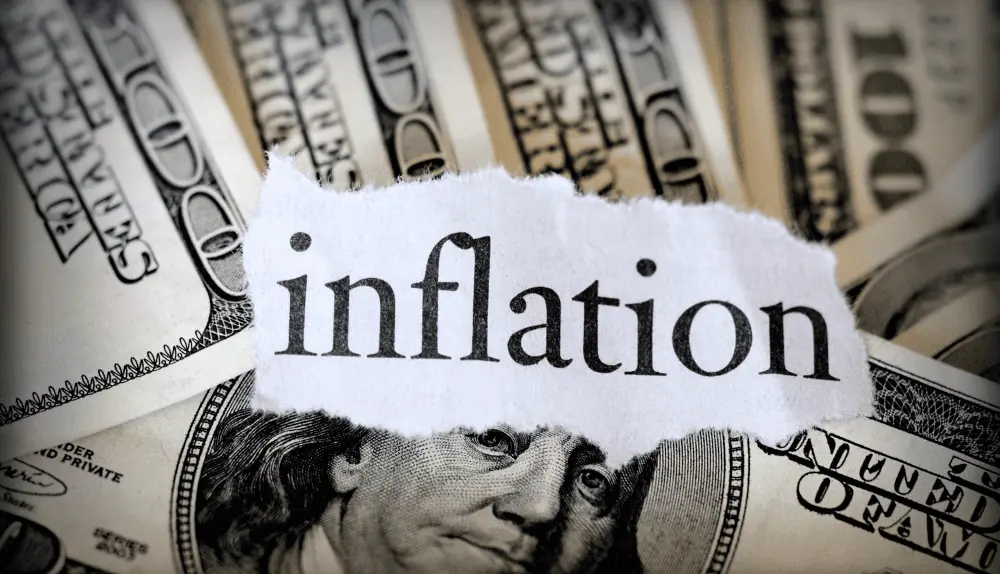Inflation is when prices of goods and services keep going up over time, and it has a big impact on the economy. As prices rise, the purchasing power of money decreases, leading to reduced consumer spending and potential economic instability. To maintain a healthy economic environment, it becomes crucial to control inflation. This article explores if you can curb inflation with financing, particularly from the perspective of businesses, and examines the role that financing, such as business loans, can play in this regard.
Definition of inflation and its impact on the Economy
Inflation occurs when the overall prices of goods and services within an economy rise over a given period. This diminishes the purchasing power of money and lowers consumers’ ability to buy. When inflation remains unchecked, it can have several adverse effects on the economy. Firstly, it can disrupt the stability of financial markets, making it difficult for businesses to plan and invest. Moreover, inflation can result in higher production expenses, posing difficulties for businesses to sustain profitability and provide competitive pricing. Additionally, inflation can create uncertainty among consumers, who may choose to delay purchases, impacting businesses’ sales and revenue.
Importance of controlling inflation for businesses

Controlling inflation is of paramount importance for businesses, as it directly affects their operations and profitability. Rising prices can squeeze profit margins, making it essential for businesses to find effective strategies to combat inflationary pressures. One approach that businesses can consider is to use a business loan to combat inflation. By securing financing, businesses can invest back into their operations, which can help offset rising costs and maintain their competitive edge. Whether it involves upgrading machinery, enhancing production capabilities, or investing in research and development, applying for a business loan to invest back into your operation can provide the necessary resources to mitigate the impact of inflation.
Understanding Inflation

Definition and causes of inflation
Inflation is the continuous rise in the overall price level of goods and services in an economy. It is primarily driven by two main factors: demand-driven inflation and cost-driven inflation. Demand-driven inflation occurs when the total demand for goods and services surpasses the economy’s ability to produce them, resulting in upward pressure on prices. On the other hand, cost-driven inflation arises when the costs of production inputs, such as labor, raw materials, or energy, increase, compelling businesses to increase prices to maintain profitability.
Different types of inflation
As previously mentioned, demand-pull and cost-push are two prevalent forms of inflation. Demand-pull inflation typically occurs due to factors like heightened consumer spending, expansionary fiscal policies, or accommodative monetary policies that generate excessive demand compared to supply. In contrast, cost-push inflation generally stems from factors such as escalating wages, increased taxes, rising production costs, or disruptions in the supply chain. Both types of inflation can have substantial ramifications for businesses.
Effects of Inflation on businesses
- Increased costs of production: Inflation leads to higher costs of raw materials, energy, wages, and other inputs necessary for production. As businesses face increased expenses, their profit margins may shrink, affecting their overall profitability. This can be particularly challenging for small and medium-sized enterprises (SMEs) with limited resources and bargaining power.
- Reduced purchasing power of consumers: Inflation erodes the purchasing power of consumers as prices rise. When people’s income remains stagnant while prices increase, their ability to afford goods and services diminishes. This can lead to reduced consumer spending, impacting businesses’ sales and revenue.
- Uncertainty and planning challenges: Inflation introduces uncertainty into the business environment. Rapidly changing prices and unpredictable market conditions make it difficult for businesses to plan for the future effectively. Inflationary pressures may require companies to adjust pricing strategies, reevaluate budgets, and modify long-term investment plans, adding complexity to decision-making processes.
Can You Curb Inflation With Financing?

Overview of financing options available to businesses
Businesses have various financing options at their disposal to address inflationary pressures:
- Debt financing: This involves borrowing funds from financial institutions or lenders. Business loans, lines of credit, or commercial mortgages are common forms of debt financing. They provide immediate capital that can be used to address rising costs, invest in growth opportunities, or manage cash flow during inflationary periods.
- Equity financing: Equity financing involves raising capital by selling shares of ownership in the business. This can be done through private investors, venture capitalists, or even by going public through an initial public offering (IPO). Equity financing allows businesses to access funds without incurring debt, providing flexibility during inflationary times.
- Government-backed financing programs: Governments often offer financing programs to support businesses, especially during economic challenges. These programs may include low-interest loans, grants, or subsidies aimed at stimulating growth and curbing inflation. Businesses can explore these programs to access additional capital and support.
Role of Financing in managing inflation
- Financing for capital investments: Businesses can use financing to make essential capital investments that help counteract the effects of inflation. By upgrading technology and machinery, companies can improve productivity, reduce production costs, and enhance operational efficiency. Additionally, financing can enable businesses to expand their production capacity, allowing them to meet increased demand and mitigate potential supply shortages.
- Financing for research and development: Investing in research and development (R&D) can foster innovation and help businesses stay ahead in competitive markets, even during inflationary periods. Financing R&D initiatives enables businesses to develop new products, improve existing ones, or explore cost-saving measures. These efforts can lead to increased efficiency, reduced costs, and enhanced competitiveness, ultimately combating the effects of inflation.
- Financing for marketing and sales strategies: Inflation can impact consumer behavior and purchasing patterns. By utilizing financing for marketing and sales strategies, businesses can adapt their approaches to target customers more effectively. This may involve implementing targeted advertising campaigns, expanding distribution networks, or offering promotions to maintain customer loyalty and offset potential declines in sales.
Case studies/examples of businesses successfully using financing to curb inflation
Numerous businesses have successfully utilized financing to combat inflationary pressures. For instance, a manufacturing company secured a business loan to invest in advanced machinery and automation technology. This increased their production efficiency, reduced costs, and allowed them to maintain competitive prices despite inflationary pressures.
In another case, a technology startup raised equity financing, enabling them to expand their R&D capabilities. This resulted in the development of innovative products that offered cost-effective solutions, gaining a competitive edge in the market.
Furthermore, a retail business utilized a government-backed financing program to launch targeted marketing campaigns and improve its online presence. This strategic investment helped them attract new customers, boost sales, and mitigate the impact of reduced consumer purchasing power during inflationary times.
These examples demonstrate how businesses can effectively leverage financing to curb inflation by making capital investments, fostering innovation, and implementing strategic marketing approaches.
Challenges and Limitations
Impact of interest rates on financing decisions
Interest rates play a crucial role in financing decisions and can pose challenges during inflationary periods. When inflation rises, central banks often raise interest rates to control the economy. This can lead to increased borrowing costs for businesses seeking financing. Higher interest rates can make it more expensive for businesses to service their debt, potentially impacting their profitability and ability to invest in growth initiatives. It is essential for businesses to carefully assess the interest rate environment and factor in potential rate increases when considering financing options.
Potential risks and drawbacks of excessive borrowing
While financing can be a valuable tool to combat inflation, excessive borrowing carries risks and drawbacks. Taking on too much debt can strain a business’s financial position and create vulnerabilities during economic downturns. Excessive borrowing can lead to higher debt servicing costs, reduced cash flow, and increased financial leverage. Businesses must assess their borrowing capacity, establish a prudent debt-to-equity ratio, and ensure they can comfortably meet their repayment obligations.
Market conditions and availability of financing options
The availability of financing options can be influenced by market conditions. During periods of economic uncertainty or financial instability, lenders may tighten their lending criteria and become more cautious in extending credit. This can make it more challenging for businesses to access financing, especially for those with weaker credit profiles. Additionally, market conditions can impact interest rates, loan terms, and the overall cost of financing. Businesses need to closely monitor market conditions and be prepared to adapt their financing strategies accordingly.
Role of government policies and Regulations
Government policies and regulations can significantly impact the financing landscape. Changes in regulations, such as stricter lending requirements or alterations to interest rate policies, can affect businesses’ access to financing. Government intervention, such as the implementation of macroprudential measures or stimulus packages during inflationary periods, can also influence the availability and terms of financing. Businesses must stay informed about relevant policies and regulations to effectively navigate the financing environment.
Other Strategies to Curb Inflation
Pricing strategies
Effective pricing strategies can help businesses navigate inflationary periods and mitigate the impact of rising costs. Two common approaches are:
- Cost-based pricing: This strategy involves setting prices based on the production costs incurred, including materials, labor, and overhead expenses. By carefully analyzing and managing costs, businesses can adjust their pricing to maintain profit margins despite inflation. Cost control measures, such as optimizing operational efficiency and exploring alternative suppliers, can help mitigate cost increases.
- Value-based pricing: Value-based pricing focuses on the perceived value that customers derive from a product or service. Instead of solely basing prices on costs, businesses consider factors such as quality, innovation, and customer demand. By emphasizing the value proposition and effectively communicating the unique benefits of their offerings, businesses can justify higher prices and maintain profitability during inflationary periods.
Supply chain optimization
Optimizing the supply chain can help businesses mitigate the impact of inflation by reducing costs and ensuring efficient operations. This involves streamlining processes, improving inventory management, and enhancing collaboration with suppliers. By seeking cost-effective sourcing options, negotiating favorable contracts, and minimizing transportation and logistics expenses, businesses can effectively manage supply chain costs and minimize the impact of inflation.
Inventory management techniques
Effective inventory management is crucial during inflationary periods. Businesses should carefully analyze demand patterns, forecast future needs, and adjust inventory levels accordingly. By adopting just-in-time (JIT) inventory management techniques, businesses can minimize holding costs and reduce the risk of inventory obsolescence. This ensures that inventory levels are optimized to meet customer demand while minimizing the financial impact of inflation on carrying costs.
Negotiating with suppliers and vendors
During inflationary periods, businesses can proactively engage in negotiations with suppliers and vendors to secure favorable terms. Exploring alternative suppliers, seeking volume discounts, and negotiating extended payment terms can help offset the impact of price increases. Building strong relationships with suppliers and maintaining open lines of communication can facilitate productive negotiations and potentially lead to cost savings.
Innovations in production processes
Innovating production processes can drive efficiency gains and mitigate the impact of inflation. By embracing new technologies, automation, and lean manufacturing principles, businesses can reduce production costs, improve productivity, and enhance quality. Innovations that enhance resource utilization, reduce waste, and optimize energy consumption contribute to cost savings and enable businesses to maintain competitive pricing in the face of inflationary pressures.
Bottom Line
In this article, we explored various aspects of curbing inflation for businesses. We defined inflation, discussed its impact on the economy, and highlighted the importance of controlling it. We then delved into the role of financing as a tool to combat inflation, including different financing options and their applications.
Financing can be an effective strategy to address inflationary pressures, enabling businesses to make capital investments, support research and development, and implement strategic marketing initiatives. However, its effectiveness depends on factors such as interest rates, borrowing limits, and market conditions.
Managing inflation requires a multi-faceted approach. Businesses should not solely rely on financing but also employ pricing strategies, optimize supply chains, implement inventory management techniques, negotiate with suppliers, and innovate production processes.
Looking ahead, financing will continue to play a crucial role in controlling inflation. Businesses will need to adapt to evolving market conditions, navigate government policies, and explore innovative financing solutions to effectively manage inflationary pressures and sustain long-term growth. A comprehensive approach that combines financing with other strategies will be essential for businesses to thrive in an inflationary environment.
FAQs
1. How does financing help in curbing inflation?
The financing provides businesses with the necessary capital to invest in productivity-enhancing measures, such as upgrading technology, expanding production capacity, and conducting research and development. These initiatives can help reduce production costs, increase efficiency, and maintain competitiveness despite inflationary pressures.
2. What financing options are available for businesses to combat inflation?
Businesses can explore various financing options, including business loans, lines of credit, equity financing, and government-backed financing programs. Each option offers different advantages and considerations, allowing businesses to choose the most suitable option based on their specific needs and circumstances.
3. Are there any risks associated with using financing to combat inflation?
Yes, there are risks to consider. Excessive borrowing can strain a business’s financial position and lead to higher debt servicing costs. It is important for businesses to carefully assess their borrowing capacity and establish a prudent debt-to-equity ratio to avoid overextending themselves financially.
4. Is financing the only strategy businesses should use to address inflation?
No, financing should be part of a multi-faceted approach. Businesses should also consider implementing pricing strategies, optimizing their supply chain, managing inventory effectively, negotiating with suppliers, and innovating production processes. A comprehensive approach helps mitigate the impact of inflation and enhances overall resilience.
5. How can businesses determine the appropriate financing option for their inflationary challenges?
Businesses should evaluate their specific needs, financial situation, and long-term goals. Factors such as interest rates, repayment terms, borrowing limits, and the availability of financing options in the market should be considered. Consulting with financial advisors or experts can provide valuable insights and help businesses make informed financing decisions.
6. Can finance alone eliminate the effects of inflation on businesses?
While financing can provide support, it may not eliminate the effects of inflation. Inflation is a complex economic phenomenon influenced by various factors beyond a business’s control. Employing a combination of financing strategies and other inflation-mitigating measures can help businesses navigate and manage inflationary pressures more effectively.

